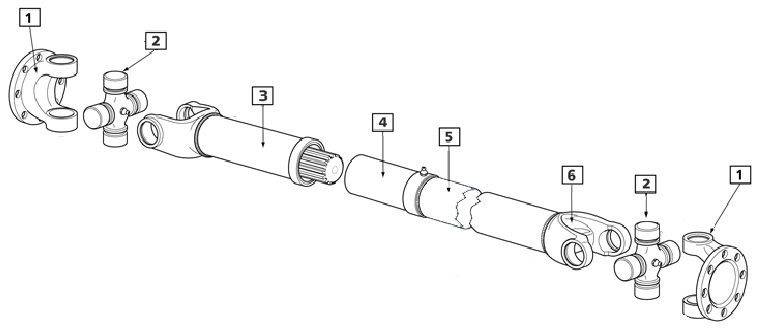What makes up a propshaft?
When people ring us to ask questions on what we can do for them, they tend to struggle in explaining what part of their propshaft has failed or what they are looking for
As a little guide here are them main components that make up the most common propshaft, The sliding shaft.

1: Flange Yoke
Yes “Flange” does seem an odd word but its meaning is “A protruding rim, edge, rib, or collar, as on a wheel or a pipe shaft, used to strengthen an object, hold it in place, or attach it to another object”
In the propshaft world we use it to attach to another object such as Gearbox, Differential, PTO or another propshaft. It is connected to the propshaft via two Yoke ears that hold on to one plane of the universal joint.
2: Universal Joint
This is the most commonly known part of a propshaft and the easiest part to replace DIY. It’s known by a few different names, Universal Joint, Cardan Joint, UJ, Hardy Spicer and Hookes Joint to name a few. One thing it is not is a CV joint. This is something completely different that we will probably cover in a later blog. Universal joints revolve around four bearing caps and it is these bearing caps that usually wear. Especially if they are not maintained.
3 and 4: Sliding section
The sliding section has several different functions depending on the application. The two main applications are automotive and industrial. When a sliding shaft is used in an automotive application the sliding section allows for the propshaft to compress and extend due to the rise and fall of the axle’s. In an industrial application there is usually very little if any compression or extension needed so the sliding section is used more for ease of installation (some industrial shafts do not contain a sliding section). The sliding section consists of two parts, The female spline and the male spline. We always change both sections if there is a problem with excess movement as both the male and female tend to wear at the same rate. This involves removing the sliding section from the universal joint and cutting it out of the tube.
5: Tube
Lots of people imagine propshaft tube is just any old tube but sadly that’s not the case. Most of it is DOM mechanical tube with a uniform wall thickness. We have had quite a few people come in with their own DIY propshaft for balancing which have been made out of scaffolding tube or thick walled pipe and sadly we have had to start again. Propshaft tube isn’t as thick as you may think. Automotive shafts range from 1.5mm wall thickness up to 6mm. It’s strength comes from its wall thickness but most importantly it’s diameter. The longer the propshaft then the bigger the diameter and wall thickness. We use MIG welding to attach the sliding section and the tube yoke to the tube.
6: Tube Yoke
Tube yokes are also known as Weld Yokes. They and are a fixed point welded into the tube that the second universal joint attaches to. They are very similar to the sliding yoke but without the obvious slide.
And now we are back to the Universal Joint and the Flange Yoke.
Not all the components look exactly like they do in the drawing but the component names are the same.
We do get quite a few people coming in to us with vibration problems coming from their homemade Propshafts. We are happy to try and help and perfectly understand people trying to save money were they can, especially on self build kit cars but we can make complete new shafts to the customer specification within a few hours at prices starting at £70 + VAT
It worth a quick call to see what we can do for you.
I’m quite interested to know if anyone reads the blog posts and if they find them informative.
Comments on the blog posts would be greatly appreciated.
Please click the contact email below this blog.
If you would like me to cover a particular topic in one of our blogs then please email me also.